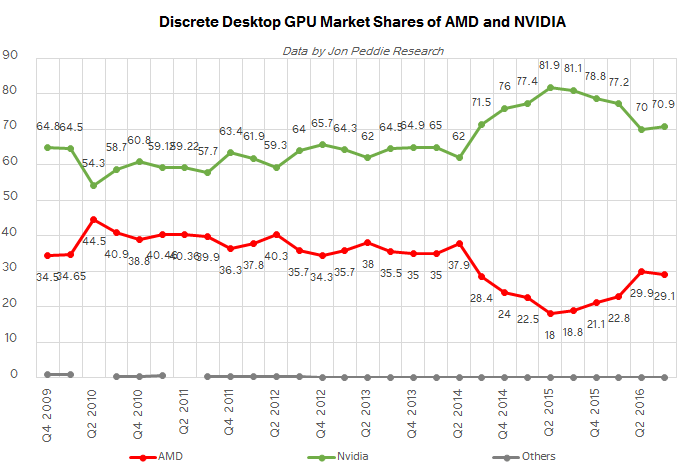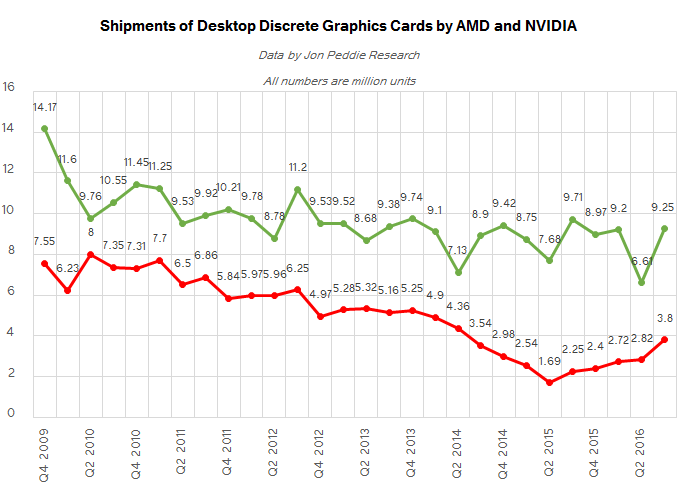Discrete Desktop GPU Market Trends Q3 2016: GPU Shipments Hit Two-Year High
by Anton Shilov on November 28, 2016 9:00 AM ESTMarket Share: AMD Is Increasing Units, Not Share
Last year AMD addressed the high-end of the market with unique products like the Radeon R9 Fury series with HBM memory, as well as the Radeon R9 Nano aimed at small form factor systems. This year the company decided to focus on mainstream video cards with its Radeon RX series (previously known as Polaris). So far, this tactic has been paying off: over the past 12 months, AMD regained over 10% of the market and increased quarterly shipments of desktop discrete GPUs by over 1.5 million units.
AMD shipped approximately 3.8 million standalone graphics chips for desktop computers in the third quarter of 2016, which is a two-year high, according to Jon Peddie Research. The company’s desktop discrete GPU sales were up nearly one million units from the previous quarter (an increase of 34%) and grew by over 1.5 million units from the same period last year (an increase of 68.8%). Meanwhile, AMD’s market share declined 0.8% from the previous quarter (Q2 2016) due to strong NVIDIA performance but surged 10% from Q3 2015.
NVIDIA also managed to increase its discrete desktop GPU shipments in the third quarter significantly. The company sold 9.25 million GPUs, up from 6.61 million in Q2 2016 (an increase of about 40%), and up from 8.97 million in Q3 2015 (an increase of 3.1%). NVIDIA typically clears out its inventory in the second quarter, hence, its sequential growth of chip sales in the third quarter is not particularly surprising. Meanwhile, the company has managed to bring its sales back to recent historical levels, which is not bad on a market that has been on a decline for years.












53 Comments
View All Comments
RussianSensation - Friday, December 2, 2016 - link
I5 2500K/2600K turn 7 years old next month, since they were released on January 2011!catavalon21 - Sunday, December 11, 2016 - link
How about splitting the difference, and call it 6 years old?Araa - Monday, November 28, 2016 - link
Never been an AMD fan myself but I hope they get out of the slumber they are currently in. I want the good ol' 2010 days back where they were a strong second.Keao - Monday, November 28, 2016 - link
Yeah and back then GPU mid-tier was a bargain :-)Aaaah I miss the days of the RADEON HD4870...
Stuka87 - Monday, November 28, 2016 - link
In 2010 AMD was in first place. Thats back when the 5000 series was king of the hill and the GTX 400 series was delayed 6 months and shipped as a power guzzling pig. It was later on when the updated 500 series brought nVidia back in front as the AMD 6000 series was just a basic re-badge.silverblue - Tuesday, November 29, 2016 - link
Not quite; the 6900 series moved from VLIW5 to VLIW4 due to AMD realising that the average slot utilisation was 3.4, hence there were efficiency gains to be made in reducing the size of each shader block. The 6870 and below were based off the 5000 series, however.just4U - Friday, December 2, 2016 - link
While the 470/80 were guzzlers for sure .. the 460 was the little darling... priced well and gave Nvidia fans something to cheer about. The 500 series certainly brought more to the table, however AMD was matching them in performance while beating them on pricing...I always remember wanting a 560Ti or a 570 but could never justify it on the price so opted for the AMD equivalent... sad to because even as it was about to be discontinued the damn cards never did come down in price. That's when I started to get a little miffed with Nvidia. After the TNT2 They really began to sock it to you price wise with the Geforce line... That's something ATi never really did... even when they were the king of graphics in the early 90s.
Strunf - Thursday, December 8, 2016 - link
ATI/AMD, nVIDIA will charge as much as they can... there are no good guys, they are quoted on the stock market and hence profit driven.In the early 90s the graphics card wasn't so important and there were a few players ATI, S3, Matrox, Intel... then the 3D accelerators kicked in and the market went crazy.
Samus - Tuesday, November 29, 2016 - link
I haven't had an AMD GPU since AMD bought ATI that I liked. They were cheaper, for the same performance as nVidia, but they failed early, the drivers were awful, and their partners were and still are lousy. AMD doesn't have an equivalent OEM builder to nVidia such as PNY or EVGA.And before you laugh about PNY, remember that PNY is actually the largest distributor of nVidia cards. By quite a lot. I remember reading a few years ago that PNY shipped more cards than every other nVidia partner COMBINED. All those Quadro's have helped their bottom line as well.
peterfares - Wednesday, November 30, 2016 - link
ASUS makes AMD cards. They're reputable.